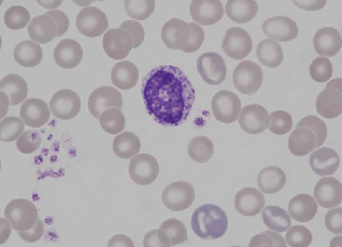Images scientifiques

Basophil of a Brown Norway rat with a ring-shaped nucleus that is broken and appearing C-shaped. The cytoplasm contains numerous basophilic granules.
<p>Basophil of a Brown Norway rat with a ring-shaped nucleus that is broken and appearing C-shaped. The cytoplasm contains numerous basophilic granules. </p>

The nucleus is doughnut-shaped with a clear outline suggesting that the basophil is relatively juvenile. Numerous small, purple granules are present.
<p>The nucleus is doughnut-shaped with a clear outline suggesting that the basophil is relatively juvenile. Numerous small, purple granules are present.</p>

Typical eosinophil of a rat. The doughnut-shaped nucleus is twisted and there are numerous small, round, reddish granules filling the cytoplasm.
<p>Typical eosinophil of a rat. The doughnut-shaped nucleus is twisted and there are numerous small, round, reddish granules filling the cytoplasm.</p>

Large lymphocytes have a diameter up to 15 μm with a variable amount of cytoplasm, varying from deep to pale blue, sometimes containing large, dark staining, azurophilic granules.
<p>Large lymphocytes have a diameter up to 15 μm with a variable amount of cytoplasm, varying from deep to pale blue, sometimes containing large, dark staining, azurophilic granules.</p>

Small lymphocyte in the upper left, monocyte in the centre, neutrophil in the lower left of the high-power field. Mild platelet aggregation.
<p>Small lymphocyte in the upper left, monocyte in the centre, neutrophil in the lower left of the high-power field. Mild platelet aggregation.</p>

Metamyelocyte with a smooth, doughnut-shaped nucleus and bluish cytoplasm. Metamyelocytes are usually not found in the peripheral blood of rats. This blood smear is of an aged animal showing a picture of anaemia.
<p>Metamyelocyte with a smooth, doughnut-shaped nucleus and bluish cytoplasm. Metamyelocytes are usually not found in the peripheral blood of rats. This blood smear is of an aged animal showing a picture of anaemia.</p>

Rat monocyte with distinctive characteristics such as the colour shade of the cytoplasm and presence of vacuoles. The nucleus has a sharp notch.
<p>Rat monocyte with distinctive characteristics such as the colour shade of the cytoplasm and presence of vacuoles. The nucleus has a sharp notch.</p>

